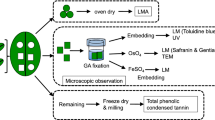Abstract
In Quebracho colorado heartwood tannins are located in the lumina of most parenchyma cells, fibres and vessels. Formation and deposition of the tannins were studied by electron microscopy. In parenchyma cells phenolic compounds first occur at the inner and outer side of the membranes of vacuoles. Later, these vacuoles are completely filled with dark stained compounds and fuse together. From parenchyma cells the phenolic substances migrate into the lumina of fibres and vessels through pits. In pits they penetrate into the compound middle lamella (CML) and diffuse along the CML. Tannins were also found in the cell walls and in fissures within the CML and G-layer of tension wood fibres.
Zusammenfassung
Im Kernholz von Quebracho colorado kommen Tannine in den Lumina der meisten Parenchymzellen, Fasern und Gefäße vor. Bildung und Ablagerung der Tannine wurden elektronenmikroskopisch untersucht. In Parenchymzellen treten phenolische Verbindungen zuerst an der Innen- und Außenseite der Membranen von Vakuolen auf. Später sind diese Vakuolen vollständig mit dunkel kontrastierten Substanzen gefüllt und verschmelzen miteinander. Von Parenchymzellen gelangen phenolische Substanzen durch Tüpfel in die Lumina von Fasern und Gefäßen. In Tüpfeln dringen sie in die Mittelschicht ein und diffundieren entlang der Mittelschicht. Tannine wurden auch in den Zellwänden und in Rissen in der Mittelschicht und der G-Schicht von Zugholzfasern gefunden.
Similar content being viewed by others
5 References
Besold, G. 1992: Die Holzwirtschaft in Argentinien. Holz-Zentralbl. 118: 481–484
Fengel, D. 1966a: Elektronenmikroskopische Beiträge zum Feinbau des Buchenholzes (Fagus sylvatica L.) — Zweite Mitteilung: Weitere Beobachtungen an Markstrahlzellen der Buche. Holz Roh- Werkst. 24: 177–185
Fengel, D. 1966b: Elektronenmikroskopische Beiträge zum Feinbau des Buchenholzes (Fagus sylvatica L.) — Dritte Mitteilung: Die Feinstruktur der Tüpfel in Buchenholz. Holz Roh- Werkst. 24: 245–253
Fengel, D. 1989: Chemistry and morphology of Quebracho colorado wood. 5th Intern. Symp. Wood Pulp Chem., Raleigh, N.C., USA, Proc. Poster Sess.: pp. 267–269
Fengel, D.;Wenzkowski, M. 1989: Über die Ablagerung von Tannin im Kernholz von Quebracho colorado (Schinopsis balansae Engl.). Holz Roh-Werkst. 47: 480
Hillis, W. E. 1971: Distribution, properties and formation of some wood extractives. Wood Sci. Technol. 5: 272–289
Maurer, A.;Fengel, D. 1990: A new process for improving the quality and lignin staining of ultrathin sections from wood tissues. Holzforschung 44: 453–460
Maurer, A.;Fengel, D. 1991: Elektronenmikroskopische Darstellung von strukturellen Einzelheiten in Nadelholz-Zellwänden anhand sehr dünner Ultramikrotomschnitte. Holz Roh-Werkst. 49: 53–56
Meyer, R.W. 1967: Tyloses. Development in white oak. For. Prod. J. 17: 50–56
Nobuchi, T.;Harada, H. 1985: Ultrastructural changes in parenchyma cells of Sugi (Cryptomerica japonica D. Don.) associated with heartwood formation. Mokuzai Gakkaishi 31: 965–973
Parameswaran, N.;Bauch, J. 1975: On the origin of phenolic compounds in the wood rays ofAbies alba. Wood Sci. Technol. 9: 165–173
Preusser, H.-J.;Dietrichs, H. H.;Gottwald, H. 1961: Elektronenmikroskopische Untersuchungen an Ultradünnschnitten des Markstrahl parenchyms der Rotbuche — Fagus sylvatica L. Holzforschung 15: 65–75
Reynolds, E. S. 1963: The use of lead citrate at high pH as an electron-opaque stain in electron microscopy. J. Cell Biol. 17: 208–212
Sachs, I. B.;Ward, J. C.;Bulgrin, E. H. 1966: Heartwood stain in red oak. Holz Roh- Werkst. 24: 489–497
Spurr, A. R. 1969: A low viscosity embedding medium for electronmicroscopy. J. Ultra-struct. Res. 26: 31–43.
Stafford, H. A. 1989: The enzymology of proanthocyanidin biosynthesis. In: Chemistry and significance of condensed tannins (Eds. R.W. Hemingway, J.J. Karchesy) Plenum Press, New York, London, pp. 47–70
Streit, W. 1993: Entstehung, Zusammensetzung und Verhalten der Tannine von Quebracho colorado (Schinopsis balansae Engl.). Dissertation Ludwig-Maximilians-Universität München.
Streit, W.; Fengel, D. 1994a: On the changes of the extractive composition during heartwood formation in Quebracho colorado (Schinopsis balansae Engl.). Holzforschung 48 Supplement: 15–20.
Streit, W.; Fengel, D. 1994b: Heartwood formation in Quebracho colorado (Schinopsis balansae Engl.): Tannin distribution and penetration of extractives into the cell walls. Submitted for publication
Author information
Authors and Affiliations
Additional information
The financial support by Enrique Welbers S.A., Buenos Aires, and the Deutsche Forschungsgemeinschaft (DFG) is greatly appreciated
Rights and permissions
About this article
Cite this article
Streit, W., Fengel, D. Formation and deposition of tannins in Quebracho colorado (Schinopsis balansae Engl.). Holz als Roh-und Werkstoff 53, 56–60 (1995). https://doi.org/10.1007/BF02716388
Issue Date:
DOI: https://doi.org/10.1007/BF02716388




